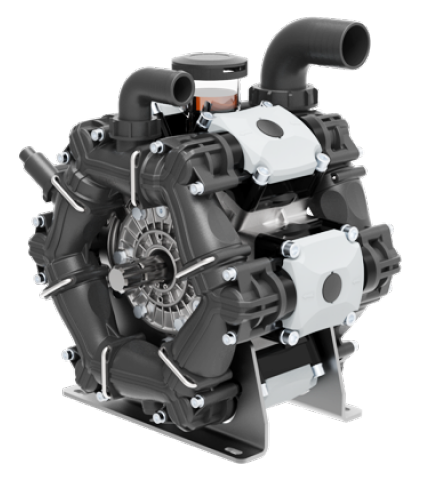The pump is necessary for supplying the working fluid during field work, filling the sprayer tank in the field, and sometimes for mixing the working fluid, although this can already be done with the help of tank agitators.
The requirements for a sprayer pump are quite high, it must provide a constant and at the same time controlled fluid flow, work with chemically aggressive substances and be easy to repair. Add here the fact that during the season the pump works almost around the clock - as much as the sprayer applicates the working fluid.
The most widespread in agriculture are two types of pumps: membrane-piston and centrifugal. Other options are much less common. These types of pumps are quite reliable and convenient.

Membrane-piston are almost like piston-type pumps, but more adapted to work with reagents used in agriculture. Due to their design, there is no contact of the main metal parts with the working fluid, which protects against corrosion and reduces the cost of production. Those parts that should be in contact with the liquid are made of stainless steel or protected.
The drive of the piston diaphragm pumps can be from the propeller shaft, hydraulic pump or electric motor.
Principle of operation: during operation of the pump, the cam shaft transfers energy to the pistons, which control the diaphragms. Instead of the traditional piston, which must be in contact with the pumped liquid, a polymer membrane is used in this pump. Its deformation affects the pressure inside the chamber. When the membrane goes down, a vacuum occurs when it goes up, the liquid in the chamber leaves it.
The advantages of this design include:
To smooth out the effect of pulsation, the chamber of the pumps may contain additional pneumatic chambers. The air in them is under a certain pressure, the value of which is set depending on the expected pressure of the working fluid.
Approximate values of pressures of working fluid and air in the chamber:
At the moment of maximum compression of the contents of the chamber, such an “air cushion” assumes pressure, partially compressing, when the chamber is emptied, this same cushion expands, contributing to a smoother flow of fluid from the chamber.

In centrifugal-type pumps, pressure build-up and the actual movement of the fluid occur under the action of pump blades. The pump impeller is located inside the spiral-shaped casing. The blades are bent in the direction opposite to the direction of rotation, which ensures the movement of fluid from the center. The pump must either be in the working solution, or the fluid is supplied using a tubes system.
When the impeller rotates, the fluid moves from the center to the periphery, from where it is diverted to the spray system.
Advantages of centrifugal pumps:
The disadvantages include the reduction of supply with increasing pressure in the fluid system and the need to fill the working cavity with liquid before starting work.
The rotation of the wheel produced by a hydraulic motor, belt drive with gear.
It is quite rare to find piston pumps, which still have certain advantages. It is this class of pumps that allows you to create high pressure of the working fluid with a small pump size. You can quickly change the pressure in the working system by controlling the speed of rotation of the pump or the stroke of its pistons.
Disadvantages due to design features - the need to seal the pistons increases the requirements for design complexity and means high wear at work. The drive such pumps can receive from tractor through driveshaft, from the hydraulic engine or the electric motor.
To increase the rate of outflow sometimes used paired installation of two pumps. If it is necessary to increase the outflow rate, the second one is turned on and the same system gives out a larger volume.
The article «Choosing sprayers…» gave an example of the calculation for choosing spray nozzles for this rate of outflow. If you change the pump, then you should consider is its performance is suitable for the upcoming loads on this sprayer. In addition, be sure to check that all pipes, flow meters and other components of the system can also miss the desired volume for a certain unit of time.
In self-propelled sprayers-spreaders series «Vodoley» uses a membrane-piston pump, which allows to use of virtually any liquid fertilizers and plant protection products used in agriculture today. Thanks to the ultra-low pressure tires, the «Vodoley» will be able to move even in heavily wet soil. Also, it is suitable for carrying out foliar feeding of winter crops - it does not damage the plants with the height less than 50 cm.